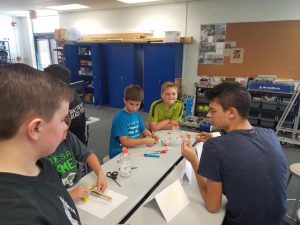What is a Youth-Adult Partnership?
“Youth-adult partnership” is a frequently used phrase among 4-H leaders, volunteers, and members. Volunteer club leaders are encouraged to foster youth-adult partnerships in the community club environment. What is a youth-adult partnership? How would a volunteer club leader begin to create this type of partnership? What is the adult role in the youth-adult partnership? Research shows that “caring, knowledgeable, and skilled adults can contribute to the success of young people as they grow and develop (Norman and Jordan, 2006). The first step in creating a youth-adult partnership is being the adult who wants to foster that environment in their 4-H club.
Positive Youth Development
4-H programs are built on a Positive Youth Development foundation. To further unpack what that phrase means, let’s begin with defining youth development. Norman and Jordan (2006) define “Youth development as an ongoing process through which young people attempt to meet their needs and to develop the competencies they perceive as necessary for survival and transition to adulthood.” When youth development is positive, this development has positive benefits and outcomes for the youth and the community. While youth development is a youth-focused process experienced by the youth, adults can and do play a role in this process. Adult leaders have the unique and special role of creating environments that provide opportunities to develop and grow in positive ways.
Zone of Proximal Development and the Role of the Adult Leader
Sociologist Lev Vygotsky studied how children learn and acquire skills. Through his research, he was able to determine that children can develop and learn to a certain point based on prior experience and knowledge. With the help of an adult teacher or leader, the child can learn more and acquire skills beyond what he or she might be able to accomplish without adult help. This learning theory is known as the “Zone of Proximal Development” (Vygostky, 1978). In 4-H, reaching the zone of proximal development where the youth-adult partnership empowers youth members to achieve is the goal we work to reach.
Working with Youth as Partners
The origin of today’s 4-H youth-adult partnership model is rooted in the work of sociologist William Lofquist. Lofquist (1989) developed the “Spectrum of Attitudes” to describe adult attitudes and approaches to working with youth. The Spectrum of Adult Attitudes places attitudes towards young people into three categories: Youth as objects; Youth as recipients; and Youth as partners (Williams, 2016). Lofquist noted that adult attitudes and the behaviors that result from these attitudes were not necessarily linear or clear cut. Youth needs may drive adult behaviors at different points in the learning and partnership process. In 4-H, adult leaders strive to transition youth from being knowledge recipients to being partners in learning and doing.
Getting Started
Adults can foster and support successful youth-adult partnerships by creating and “providing environments for youth that are safe and nurturing and by expanding opportunities for experiences that will help young people develop skills they need for adulthood” (Norman and Jordan, 2006).
The idea of moving from an adult-led club to a club that operates as a youth-adult partnership may seem intimidating. Where do we start? How does it work? Volunteer club leaders may find that it takes a while to develop a community club that functions as a successful youth-adult partnership. Adults and youth may learn together as adults yield control and youth step into expanded leadership roles.
Tips for Establishing a Youth-Adult Partnership
In the club setting, creating space for shared decision-making can help build the youth-adult partnership. When adults make decisions “with” rather than “for” youth, space is created for youth voices to be heard, for youth decisions to be validated, and for youth to develop as leaders.
When youth make decisions about activities and projects, they begin to have ownership over the club experience and move toward acting as fully empowered partners with adult leaders.
How can adults create an environment that gives youth space to develop and grow as partners? Adult leaders can start building the youth-adult partnership by helping youth develop key skills to lead and run club meetings. Steps to reaching an effective youth-adult partnership include the following activities:
- Electing youth officers and providing officer training.
- Providing whole club training in parliamentary procedure with meeting procedure practice.
- Agenda planning that includes youth and adults.
- Adults joining youth-led meetings as participants.
- Setting ground rules so that everyone is heard and respected
Getting Started
For more information and resources on 4-H clubs and youth-adult partnerships, reach out to your local Extension office or 4-H agent.
We also have several tools and resources for office training, parliamentary procedure games, and agenda planning on our Northwest 4-H Volunteer Google Site. If you would like some hands-on training, make plans to attend our Northwest 4-H Volunteer Forum January 20-21 in Destin, Florida. Registration is available on 4HOnline
References
Lofquist, W. 1989. The technology of prevention workbook: A leadership development program. Tucson, AZ: Associates for Youth Development Publications.
Norman, M.N. and Jordan, J.C. 2006. Introducing 4-H youth development. EDIS 4HFFS101.2, one of a series of the 4-H Youth Development Department, UF/IFAS Extension. Original publication date February 2006. Reviewed July 2018. Visit the EDIS website at http://edis.ifas.ufl.edu.
Vygotsky, L. 1978. Interaction Between Learning and Development. In Gauvain & Cole (Eds.) Readings on the Development of Children. New York: Scientific American Books. pp. 34-40
Williams, C.D. 2016. What is authentic youth engagement? The Governor’s Office for Children. Maryland.gov. https://goc.maryland.gov/authentic-youth-engagement/.
Additional Resources
4-H Clubs that Youth Choose to Attend
Running a Smooth 4-H Business Meeting
- All About Tabletop Exhibits for the North Florida Fair - September 10, 2024
- Beyond the Blue Ribbon: Make the Most of the 4-H Experience with Your Local Fair - July 5, 2024
- Tips to Help Youth and Families Handle Back-to-School Stress - July 28, 2023

